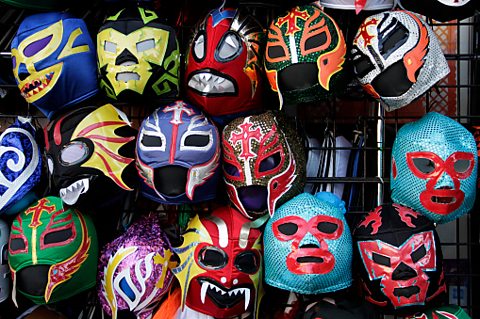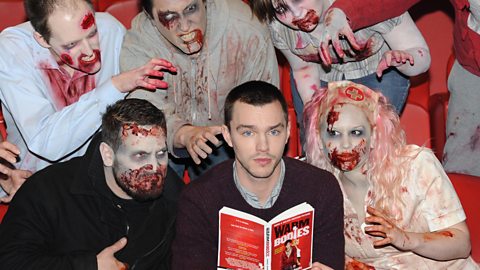Youтve probably got quite used to seeing masks in recent years.
During the pandemic, people were wearing masks more frequently, while they're also very commonplace in fancy dress. Using a mask to transform ourselves into someone different is something that goes back a long way т masks were used in ancient performances in many parts of the world.
And there is a contemporary form of entertainment that relies on them too т wrestling.
Numerous masked wrestlers have appeared in federations in Europe, Japan and the United States with Mankind and 'The Fiend' Bray Wyatt among the WWE stars to have held world titles while wearing masks.
But it was Mexican wrestlers who originally popularised the use of masks in their sport. As we all get more and more used to wearing face masks, ТщЖЙЙйЭјЪзвГШыПк Bitesize has taken a look at the history of the ГОУЁВѕГІВЙАљВЙ.
Behind the mask
While masked wrestlers are most commonly associated with lucha libre - the phrase used to describe wrestling in Mexico - the first use of a mask inside the ring was actually in Europe.

The Masked Wrestler competed in bouts in the 1860s т he was thought to be the French Greco-Roman wrestler Theobaud Bauer. Itтs not known exactly why Bauer wrestled with a mask on, but based on a report in The Times in 1867, it had the effect of creating a spectacle. The newspaper reported that Paris had been тexcited by a mysterious individual who appears masked in a circus where wrestling and feats of strength are exhibitedт.
As North America became the home of professional wrestling in the 20th Century, the first masked stars started to appear. In 1915, Mort Henderson wrestled as the Masked Marvel in the New York area.
With national organisations such as World Wrestling Entertainment (WWE) years away from forming in the United States, wrestling was still operating a territorial or state system at the time. Following Hendersonтs lead, wrestlers would sometimes start using a mask in a territory once their popularity had waned, in order to appear as a fresh new star.
Lucha libre
Lucha libre had gained popularity throughout Mexico in the early 20th Century т again, like in the United States, through a regional setup.
The style differed from the typical American approach to wrestling т with more of an emphasis on high-flying, fast-paced wrestling compared to the typical mat-based style north of the border.
Itтs often been thought that the introduction of masks was a nod to the traditions of the Aztecs or Incans, but their initial occasional use in Mexico owed more to wrestlers such as Bauer, Henderson and Cyclone Mackey.
American wrestler Mackey had competed in Mexico previously as CУclon MacKey for the newly-formed national association Empresa Mexicana de Lucha Libre (EMLL). In 1934, he was invited to return, but this time with a new persona.

Mackey wore a mask to portray a Mexican version of Hendersonтs Masked Marvel character - La Maravilla Enmascarada.
His new luchador character was an instant hit, with the mystery of the masked man hugely popular among the Mexican fanbase.
Masks became much more common in wrestling, often elaborately designed in bright colours with elements of gods, legendary figures and animals incorporated т with some wrestlers taking on parts of their identities during performances.
Although many more Mexican wrestlers were choosing to hide their faces during matches, it was the arrival of El Santo that truly saw it become a national phenomenon.

Mask versus mask
In Mexico, the majority of young wrestlers begin their careers as enmascarados т but many will eventually be unmasked, sometimes in dramatic circumstances. Luchas de apuestas, or тmatches with wagersт, are contests where a wrestler is forced not to defend a championship, but their mask itself.
Often used as the way of settling a heated feud, losing a mask to an opponent is considered to be a humiliating defeat. These bouts could feature two masked wrestlers fighting to avoid revealing their identities (ГОУЁВѕГІВЙАљВЙ contra ГОУЁВѕГІВЙАљВЙ or mask versus mask) or even between one masked fighter and one without a mask who puts their hair on the line т being shaved bald after losing the match is considered as embarrassing as losing a mask.
Once de-masked, it is very rare for a character to wear one ever again, especially if that wrestler has lost their mask in a contest. Without a mask, wrestlers either transition their career with new personas and attitudes or use the loss of the mask to lead into their retirement.

El Santo (The Saint) made his debut in 1942, wearing a silver mask. The secrecy around his true identity and background led him to become the most popular wrestler in Mexico т he had a career that lasted 40 years before his retirement in 1982.
El Santo played up to the intrigue over his true identity by never removing his mask т only revealing his face on one occasion after his retirement. He died a week later and in line with his wishes, was buried wearing his famous silver face covering.
That commitment to protecting his identity and refusing to remove his mask has gone on to become an integral part of ГОУЁВѕГІВЙАљВЙ culture to this day and one of his sons continues to pay tribute to his career today.
El Hijo del Santo (Son of the Saint) adopted his father's trademark silver mask upon his retirement - a tradition that is often a part of lucha libre where identities and character names can be passed down through families.

Three more famous masked wrestlers
Rey Mysterio т Arguably the most famous masked wrestler of the modern era, Rey Mysterio is a three-time world champion in the WWE. Mysterio was unmasked in former promotion World Championship Wrestling (WCW), but received permission from the official lucha libre commission to wear one again, despite anger from traditionalist fans. His son, Dominick, has now launched a career with the WWE, with the pair teaming at recent events.
Kane т Not a mask wearer in the traditional lucha libre sense, Kane is the storyline brother of the legendary wrestler The Undertaker who wore a mask as a result of suffering disfiguring burns as a child. Heтs removed and re-worn the mask on several occasions and the man behind the character т Glen Jacobs т is now the real-life mayor of Knox County, Tennessee. Kane was added to WWE's Hall of Fame in 2021 ahead of Wrestlemania 37.
Mil Mascaras т Considered to be one of the greatest lucha libre performers of all time, Mascaras, whose name means тa thousand masksт in Spanish, has never been unmasked. A film star in his native Mexico, Mascaras was considered the first truly international luchador and was added to WWEтs Hall of Fame in 2018.

Modern stories you didnтt know were based on Shakespeareтs plays
Which Shakespeare stories have been retold in modern films? ТщЖЙЙйЭјЪзвГШыПк Bitesize explores the reboots of the Bard

The science of superheroes
How scientifically possible are your favourite superhero's powers?

WWE's superstar Seth Rollins on... literary techniques!
Simile, metaphor, personification: WWE's Seth Rollins gives you the lowdown on figures of speech.
